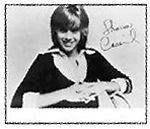The strangest thing happened to me this summer. Suddenly I’m a mess of conflicting emotions. My transformation came as an even greater shock to my system than my inexplicable fascination of late with women’s cleavage.
I’m turning into a design queen.
Contrary to mythology, not all gay men possess exquisite taste. Even after my adolescent sexual awakening, my bedroom decor hinged on a punk rock sensibility. Band posters and pictures snipped from music magazines covered every available inch of space; a 3-D collage of pop culture garbage—Weekly World News clippings, T-shirt swatches, Barbie doll limbs—dominated an entire wall. And much to my parents’ chagrin, I spray-painted the folding metal doors to my clothes closet with lyrics from The Rocky Horror Picture Show.
Since then, I’ve shown little improvement. In the early ’90s, after reading Serious Pleasures: The Life of Stephen Tennant, Philip Hoare’s biography of the infamous British aesthete, I vowed to develop my own bold approach to appointing a room. Ultimately, that meant tacking my yellowed band posters up at kooky angles and leaving a big conch shell in the shower stall until I tired of cutting my foot on it.
Finally, I accepted my blindness to good design and decorating. Now and then I might tack up a string of Christmas lights, but my idea of a little touch to brighten up the home wasn’t fresh flowers—discarding my boxer shorts in a different corner at day’s end was the height of my inspiration. While my friends fussed over kitchen implements purchased at Italian boutiques, I made do with old filling station glasses.
And then it happened. First it was a chef’s knife that called out to me. Then an Art Deco lamp. I began to appreciate subtleties of form, where once I’d only noticed ground-zero function. The quarterly design bible Nest replaced noggin-scratching music journals on my reading list. I took the plunge and braved Ikea on a weekend, ostensibly to buy sheets, but also to satisfy my rabid curiosity about the secret of their universal appeal. I didn’t find all the answers . . . just a fiery bedspread that complements my orange bed linens from London.
Judging from the parking lot that afternoon, I’m not alone in my late awakening. To what else can we attribute the success of *Wallpaper, the most lauded and maligned magazine since Martha Stewart’s Living? Or the popularity of the revamped Volkswagen Bug and the I-Mac? America is turning into a nation of design queens!
Once I condemned designers as a frivolous lot. One of my best friends in New York was a product designer, but when he’d start clucking over the tiniest details on a lipstick at Rite-Aid, I’d turn away like an embarrassed husband in the lingerie department. No more. Last week, I made a pilgrimage to savor “The Work of Charles and Ray Eames: A Legacy of Invention” at the Library of Congress, an illuminating exhibit celebrating the husband and wife team. I walked in thinking they’d made some nice chairs; I left intoxicated by their integration of disciplines from politics to fabric patterning, puppet shows to computer science.
Coincidentally, music has taken on a refreshing new perspective, too. I find myself listening to the polychromatic dance pastiche of Ursula 1000’s The Now Sound of Ursula 1000 (Eighteenth Street Lounge Music) or Air’s shimmering Premiers Symptomes (Astralwerks/Source), a collection of the French duo’s early singles, and marveling not at catchy melodies or witty lyrics but merely the seductive arrangement of tones and textures. They haven’t reinvented the wheel, but they sure rolled out a sassy new model.
Or consider the recordings of Juan Garcia Esquivel. The music critic in me previously dismissed them as annoying novelties. But listening to the forthcoming CD of his lost synesthesia masterpiece See It in Sound (out soon on the 7N label) with a design queen’s ear, I peed myself with delight. Crunching footsteps and slamming doors weave in and out of “The Peanut Vendor (El Manisero)” and “Brazil,” yielding musique concrete for the masses. Esquivel was to stereophonic sound what the Eameses were to fiberglass furniture: simultaneously practical, wacky, and forward-thinking.
Come autumn, I have to move into a new apartment. For the first time in ages, I’ll be solely responsible for decorating and furnishing a pad. Where once I loathed such a prospect, now I’m salivating when I flip through a new issue of Interiors. I’ve seen the light and embraced my new, refined sensibility, unexpected though it may be. ‘Tis better to purchase a single standing floor lamp than to curse the darkness.






